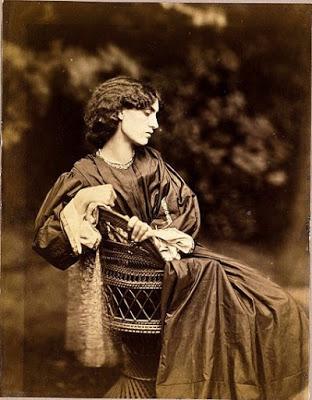
Jane Morris (1865)John Robert Parsons
Now, we all know the legend of Jane Morris - born in Oxford in 1839, then discovered one night at the theater by the ever-rampant Rossetti, who whisked her off to artistic stardom and dropped her in the lap of his best friend, William Morris. Jane and Morris married in 1859 and then this sort of thing happened...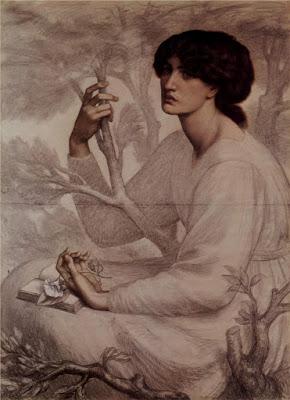
The Day Dream (1878) D G Rossetti
And this...
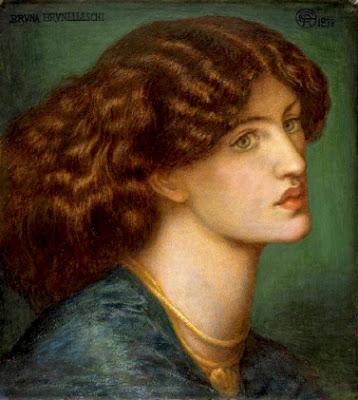
Bruna Brunelleschi (1878) D G Rossetti
And this...
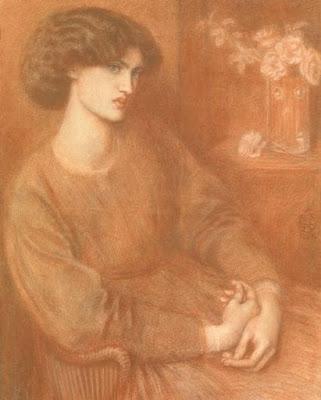
Study (1868) D G Rossetti
But then Rossetti died and everyone grew older and despite an affair with the man-slapper Wilfrid Scawen Blunt, Jane became the sort of women people talked about as 'legendary' and 'former muse', because God help any woman who gets older (as I covered in this post). Then William died, and she became 'widow of' and 'mother of' as she headed into the twentieth century...
Jane Morris (1898) Emery Walker
Jane after William - it's a tricky one as the Pre-Raphaelite women were written off as faintly meaningless when their men died. As Paull F. Baum wrote in his book of Rossetti's letters to Fanny Cornforth, without Rossetti, Fanny has no meaning, and until the new wave of scholarship starting after the 1960s, the same could be said of most, if not all, the women of the Pre-Raphaelite circle...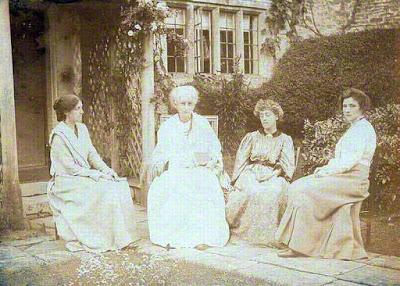
Kelmscott Manor 1905 - May, Jane, Jenny and Jenny's nurse, Ada Peerless
Despite May's disastrous marriage, Jenny's ongoing illness and her own fragile health, Jane continued to live a fairly active life into her old age. Her letters show movement and correspondence into the second decade of the twentieth century. Her last modelling job was for Evelyn de Morgan, showing the 66 year old Jane, looking mournful and regretful.
Sketch of Jane Morris for The Hourglass (1905) Evelyn de Morgan
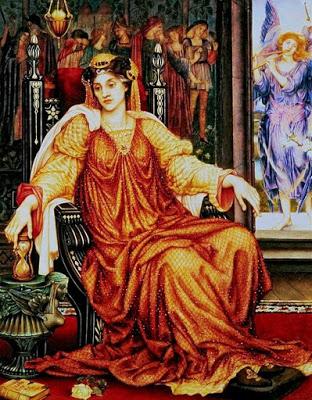
The Hourglass (1905)
It would be easy to read more into this picture than is possibly intended. A woman who had beguiled a generation of artists, who had become a legendary goddess, tall and stately, had grown old, 'lost' her looks and places a weary hand upon the hourglass, as her time trickles away. Certainly, in none of the few later photographs we have of Jane does she look happy but that does not mean she was always unhappy.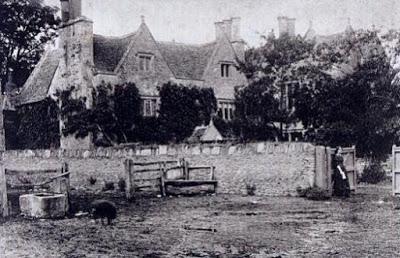
May Morris at Kelmscott Manor gate (c.1900)
Jane seems to have been at pains to secure Kelmscott Manor for her daughters to live in. The landowner, farmer Robert Hobbs (who would later sack Miss Lobb and deliver her into May Morris' life), gave no assurances that he would allow the family to live in the Manor undisturbed until the end of Jane's life and so the Manor was purchased for £4,000 in December 1913. Jane never actually lived in the Manor as its owner, as she was wintering in nearby Bath when she died suddenly.
May and Jane at Kelmscott, 1913
She was staying at 5 Brock Street in Bath, by the Circus and the Assembly Rooms. According to newspaper reports she had suffered from a short illness. Her obituary appeared in The Times on 28th January, swiftly spreading throughout local papers. Much of the reports revolve around two things - the accomplishments of her husband and her beauty. The Times recorded that she was 'an exquisite embroideress', with only one of her pieces having been displayed to the public in 1913 in Ghent. It was also suggested that her eye for color and design had been equal to her husband which is high praise indeed.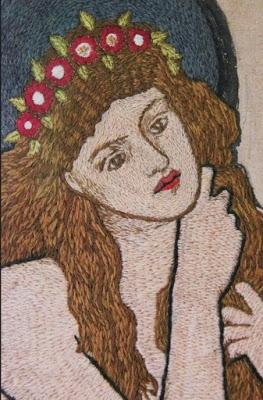
Detail of The Aphrodite Embroidery (1860) Jane Morris
There was no escaping Jane's beauty - 'All the world knows the masses of dark hair, the ivory complexion and exquisite features, the beautiful hands and the great gray eyes, which were so unique and so overwhelming in their beauty.' (The Times, 28th January 1914). Jane was forever linked with a moment in artistic time, as the Birmingham Daily Mail recorded - 'To the outside world Mrs Morris was known mainly through the reproduction of her wonderful features in the pictures of Burne-Jones and Dante Gabriel Rossetti. She was their favorite model, their feminine ideal, the peculiar pallor of the face had a fascination for them...'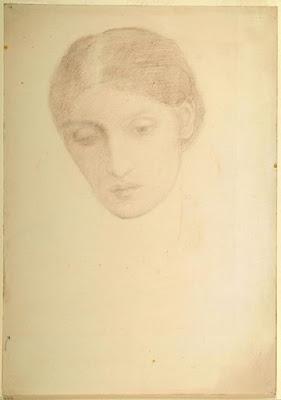
Chalk Sketch of Jane Morris (1864) Edward Burne-Jones
Just as a side note, Burne-Jones is mentioned in conjunction with her in other newspaper articles. This is unsurprising in many ways, the Morris and Burne-Jones families were close, but it is the insinuation of extra closeness between Ned Burne-Jones and Mrs Morris that is odd. The Yorkshire Post in 1925 quote from a letter from Randolph Caldecott (artist and illustrator), describing a party in Kensington, 1885. He describes playing a game where you are blindfolded and you have to place a cherry in your partner’s mouth. Mr Caldecott’s partner was Jane Morris - “She jammed her fruit into my classic mouth … but I missed hers, which as you are aware is the mouth Rossetti used so much and which Burne-Jones has studied greatly.” Interesting, Caldecott never uses the words ‘sketched’ or ‘painted’ for either man and the newspaper just leaves the quote there for their readers to read into.
Georgiana Burne-Jones, Jane Morris and their children (1874)
The Brimingham Daily Mail rather harshly kill off Georgiana Burne-Jones, claiming Jane was the last surviving of the 'sisterhood' - 'who shared the art and domestic life of the famous Brotherhood'. Mercifully the other papers managed to remember poor Georgie was still living, and her Memorials were credited with giving the story of Morris' courtship of the girl in the Oxford theater. Much is made of Jane and William's relationship in terms of their devotion and happiness, which seems odd in comparison to how we think of their marriage now. Birmingham reported how Jane's health held her back from being an active Socialist by her husband's side but 'no-one who knows his poetry can fail to be struck by the influence on him of his happy home life.'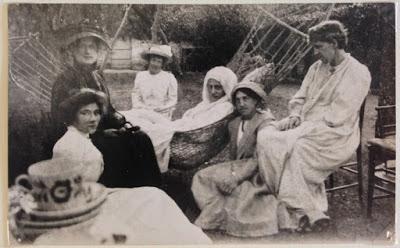
Jane Morris (centre) with visitors, and May, Jenny and Miss Peerless (1905)
Jane's funeral was held on Thursday 29th January, at Kelmscott. Her body was driven in a 'motor' from Bath to the manor house just before the service. Her coffin was 17th century style and in oak with brass furniture and a simple inscription of her name and date of death, and was carried into the church by six village men. The church was well attended by the villagers as well as familiar names from the world of art and literature including Marie Stillman whose wreath was noted in the papers. The hymn 'Now the labourer's task is o'er' was sung and the organist played the Dead March as the coffin was carried out to where William was already buried.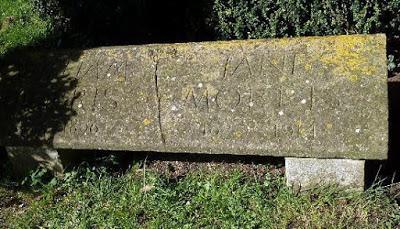
The Morris' grave at Kelmscott
It's difficult not to feel some pity for Jane Morris, who for whatever reason, did not feel entirely content with her lot in life, and despite being lifted out of the working class by her husband into a life of ease, contended with difficulties in her life that money could not solve. However, she was remembered with reverence at her death, even though she had all but disappeared from public view after William's passing almost 20 years before. Even though we now don't see the marriage as a happy one, it is kind to think that her husband's poem 'Praise of My Lady' was seen by the newspapers as having immortalised her.I'll conclude with the first stanza...
My lady seems of ivory
Forehead, straight nose, and cheeks that be
Hollow’d a little mournfully.
Beata mea Domina!
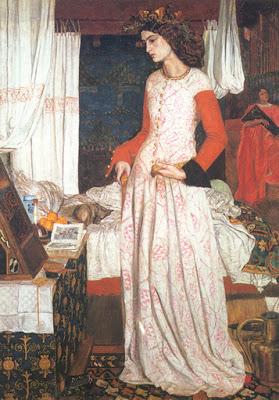
La Belle Iseult (1858) William Morris

